Tourism
TOURISMPOINTS OF INTEREST :
The starting point for a number of superb hiking routes.
Just 10km from the Super Lioran ski resort.
Tennis court: 500 m
Swimming pool: 6 km
Fishing: 500 m
horsemanship: 6 km
Cross-country skiing: 3 km
Alpine skiing: 12 km
Hiking: on site
Just 10km from the Super Lioran ski resort.
 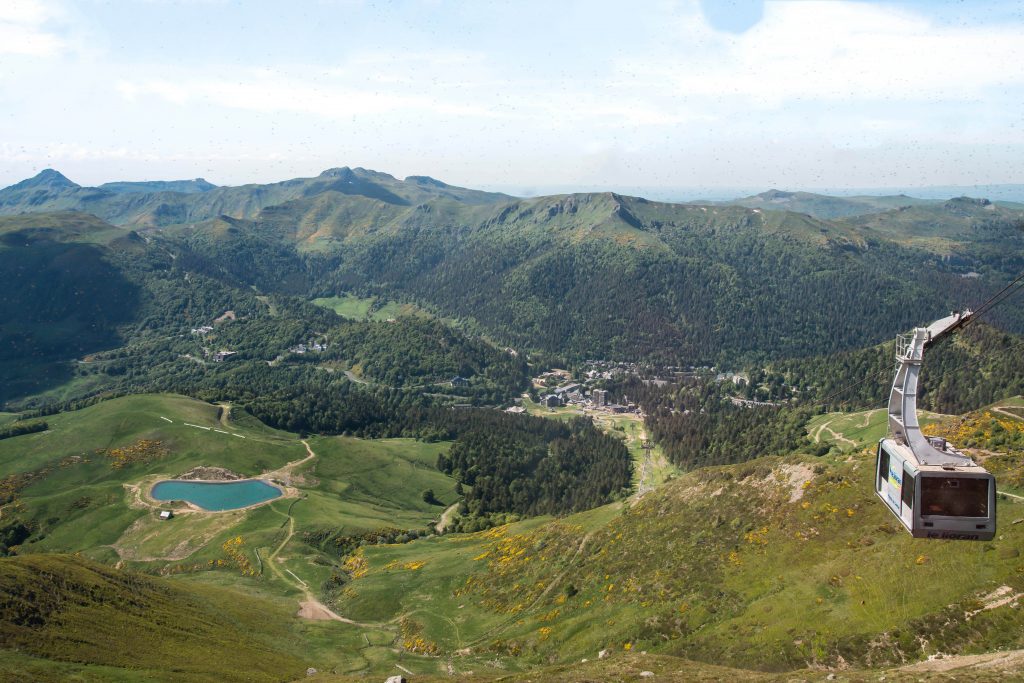 winter summer
winter summer
At the foot of many hiking trails.
Example of a hike:
Departure from Thiézac at 800 m, 17 km, 7 h. At the village fountain, take the GR 400 which goes up to the recently restored ND de la Consolation chapel (visits possible) then reaches Trielle (1090 m.). Follow the small road to the right as far as Le Clou (stopover lodge) then leave it on the left, the wide and shaded path climbs into the summer pastures, passes near the buron de la Vacherie de La Poche then turns full north to reach the Puy de La Poche (1500 m.). Descend towards the small pass (leave the GR on the right) before reaching the top of the nearby Elancèze. Do not miss to climb to the top of the point on the right from where the view is magnificent at 1571m. You can see all the main peaks of the massif and at the bottom of the valley the village of Mandailles. The second part of the hike takes place with passages alternating between forest and pasture. Passage near the ruins of the burons of the Vacherie de la Borie Haute, then the Vacherie de Braqueville. Then begins a long crossing in the forest before reaching a small road. Take it downhill to the left, then at the hairpin bend, continue to the beautiful Faillitoux waterfall. To complete the loop, you have to cross the stream and look to the left for the path that climbs to the top of the waterfall then continues in the wood along a meadow. It then turns due south then due east to climb to the Col de Lagat (1096 m.). From the pass you can see the hamlet of Lagat that you have to cross before reaching Trielle then Thiézac.
Visits to picturesque sites (passes, waterfalls, etc.).
Gorges Du Pas De Cere Cascade de Faillitoux
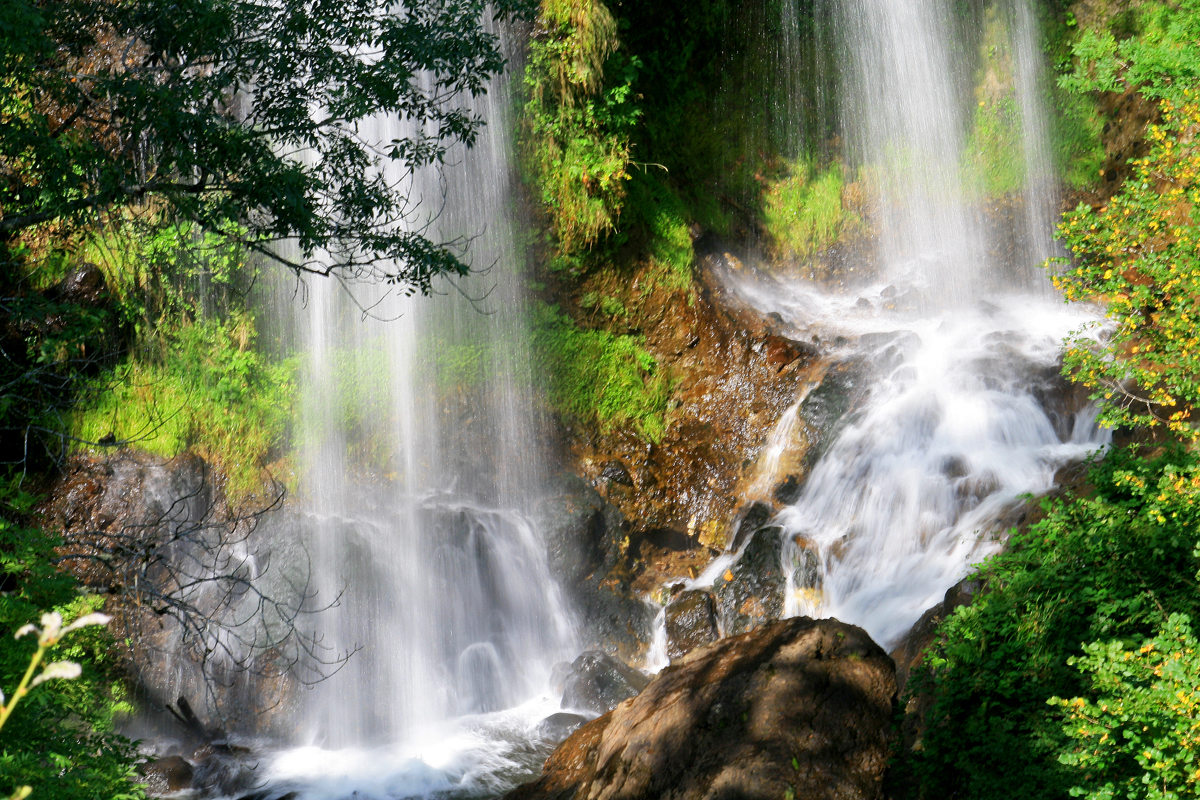 
Cascade de la Roucolle Puy de la Poche
 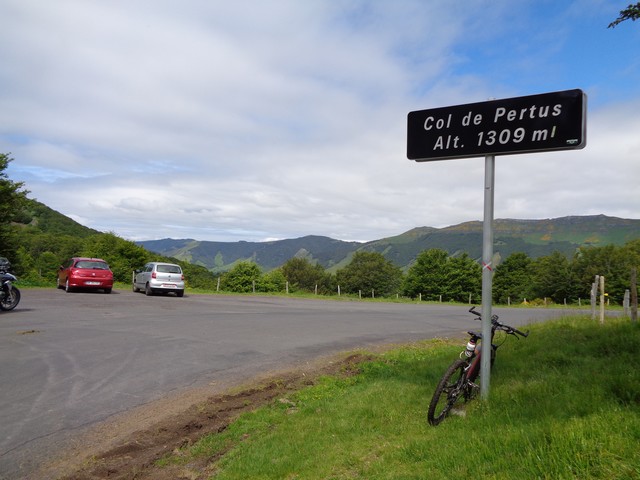 L'Élancèze Col du Perthus
L'Élancèze Col du Perthus
Patrimony.

Chapel of Our Lady of Consolation (15800 Thiézac)
Discover this charming little mountain chapel. It is an old pilgrimage chapel restored following the wars which devastated the region. Its architecture is reminiscent of that of a buron. This chapel received a painted decoration bearing the date of 1667, restored at the end of the Second Empire then around 1930. This vast mountain oratory was erected during the 15th century on the site of an apparition of the Virgin to pilgrims . The exterior is more reminiscent of a mountain buron than of a religious building, but it is its interior that makes it a remarkable element of the local heritage. Indeed the vault is entirely covered with polychrome frescoes dating from the XVIIth century, representing litanies the Virgin (more than forty medallions dedicated to the Virgin), figures and religious emblems. She was very popular and she would have received a visit from Anne of Austria who was desperate to have a son. A year after his devotions there, the future Louis XIV was born. On August 15, a torchlight procession accompanies the ascent of the statue of the Virgin in the chapel located above the village. To access the site, starting from the church, you have to follow the Stations of the Cross.
|
|
VISITSA must see in Cantal!
On vacation in Cantal? You have certainly heard of Salers, Puy Mary, from the Lioran station or even Aurillac and St Flour. Discover the 10 must-see sites, the 10 must-see sites during your stay!
Le Puy Mary, in the heart of the volcano
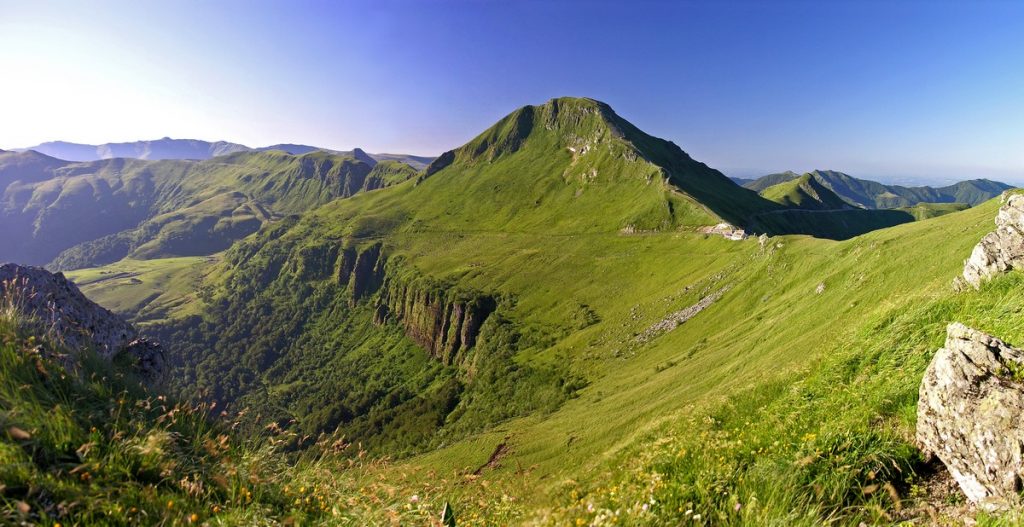
[Puy Mary volcano in Cantal]
Majestic pyramid, the Puy Mary sits in the center of the great Cantal volcano. Classified Grand Site of France, the access to the summit is arranged and will allow you to reach a breathtaking point of view easily! Le Puy Mary has become the emblem of Cantal: this visit will undoubtedly be one of the highlights of your vacation. Don't forget to take a break at the Maison de Site du Puy Mary, at the foot of the summit. You will learn more about the Cantal volcano, the formation of the landscape and the possibilities of activities in the valleys. For more information, visit: www.puymary.fr Please note: parking is chargeable in summer on the Pas de Peyrol (a € 4 sticker valid throughout the season). In addition, motor homes and coaches are prohibited from driving between 10 a.m. and 6 p.m. during the summer. Outside of these hours, the traditional direction of traffic applies to them.
Salers, medieval village
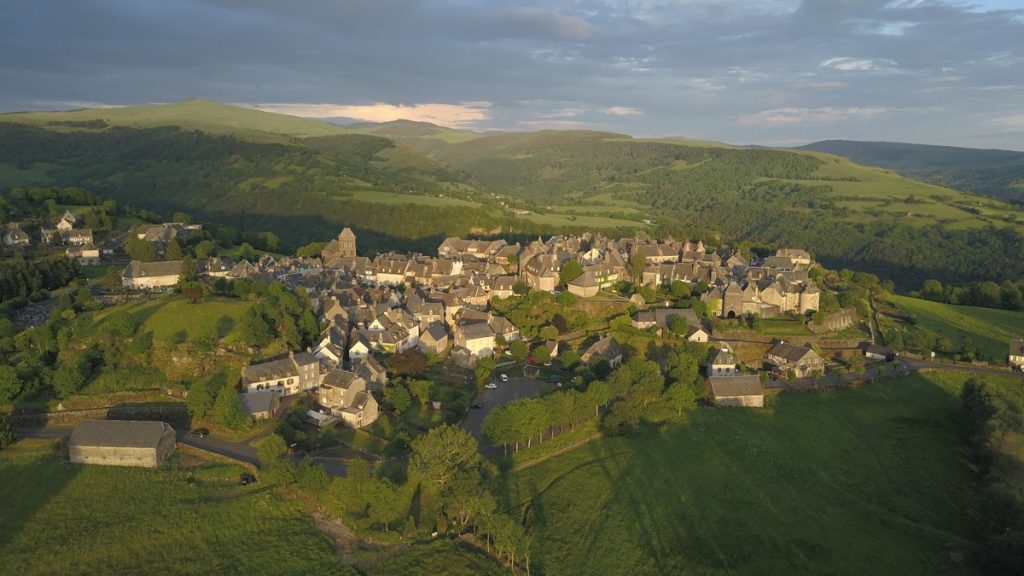
[Aerial view of Salers in Cantal]
Salers is not just a cheese! It is also a village classified among the most beautiful villages in France. Visiting Salers is an essential part of your stay in Cantal. Treat yourself to a moment out of time by strolling in Salers, and discover its turreted houses, its belfry, its ramparts ... Come stroll through the village and discover the artisans' stalls! A beautiful esplanade offers you a magnificent view of the Cantal Mountains.
For more information, visit: www.salers-tourisme.fr
The Garabit Viaduct… The Eiffel Tower in Cantal!
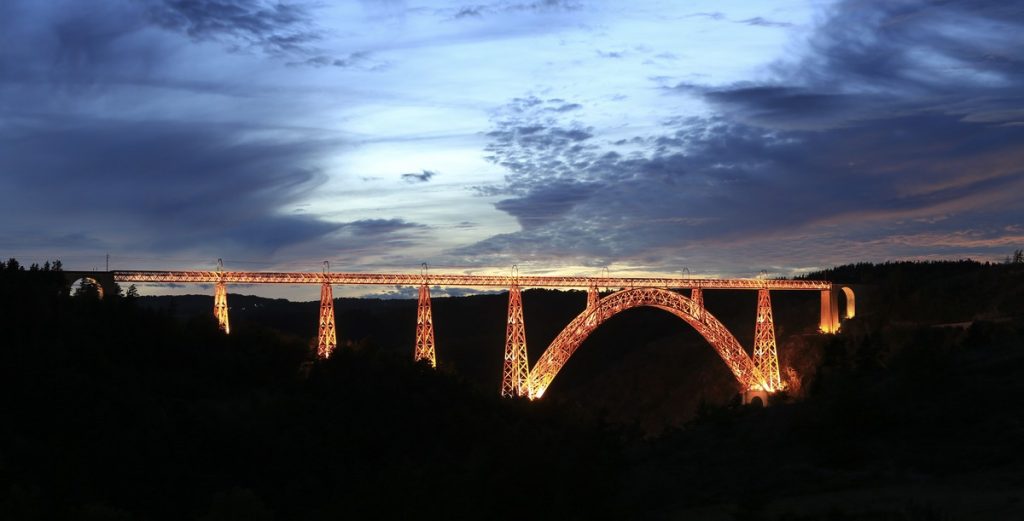
[Garabit Gustave Eiffel Viaduct]
Built by the Gustave Eiffel company, the Garabit Viaduct impresses with its size: over 500m long and 122m high.For more than 120 years, it has united the two banks of the Truyère and has aroused the admiration of visitors. Stay until nightfall to see the illuminated Viaduct: a spectacle that will delight young and old!
For more information, visit: www.pays-saint-flour.fr
Aurillac: a city… in the countryside!
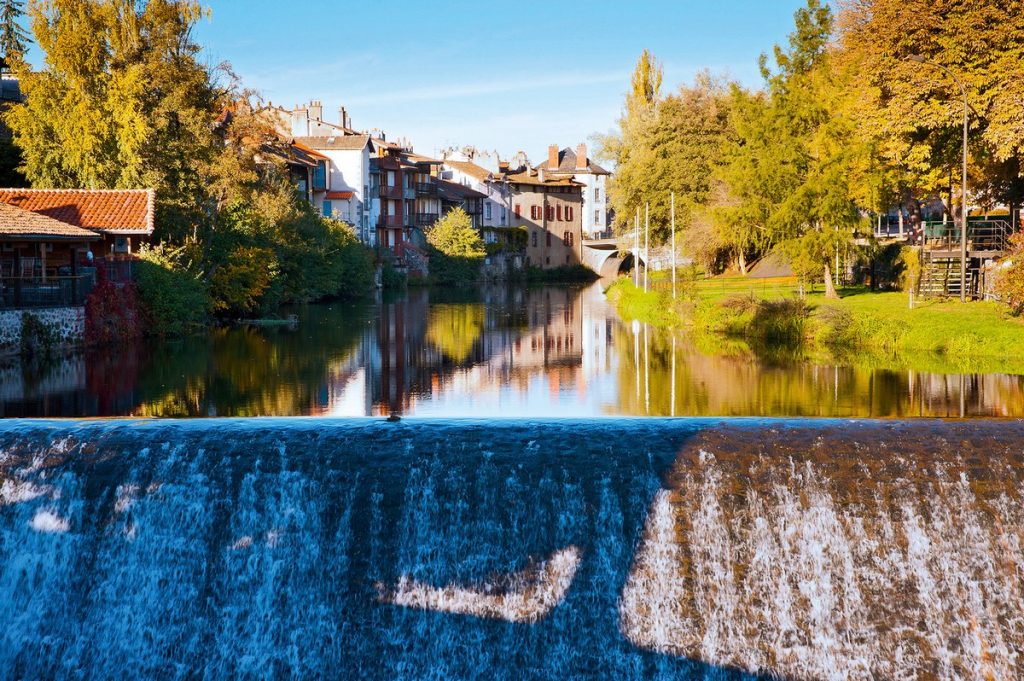
[Aurillac historic center cantal]
Take the time to discover Aurillac and its charming historic center with pleasant pedestrian streets, gardens where you can stroll, the Abbey of St Géraud and the Castle of St Etienne. The Tourist Office offers thematic tours to discover Aurillac from another angle, choose to visit the Aurillac Secret, the gourmet Aurillac or even the treasures of Aurillac especially for children!
For more information, visit: www.iaurillac.com
Tournemire and the Castle of Ajony: a tumultuous history
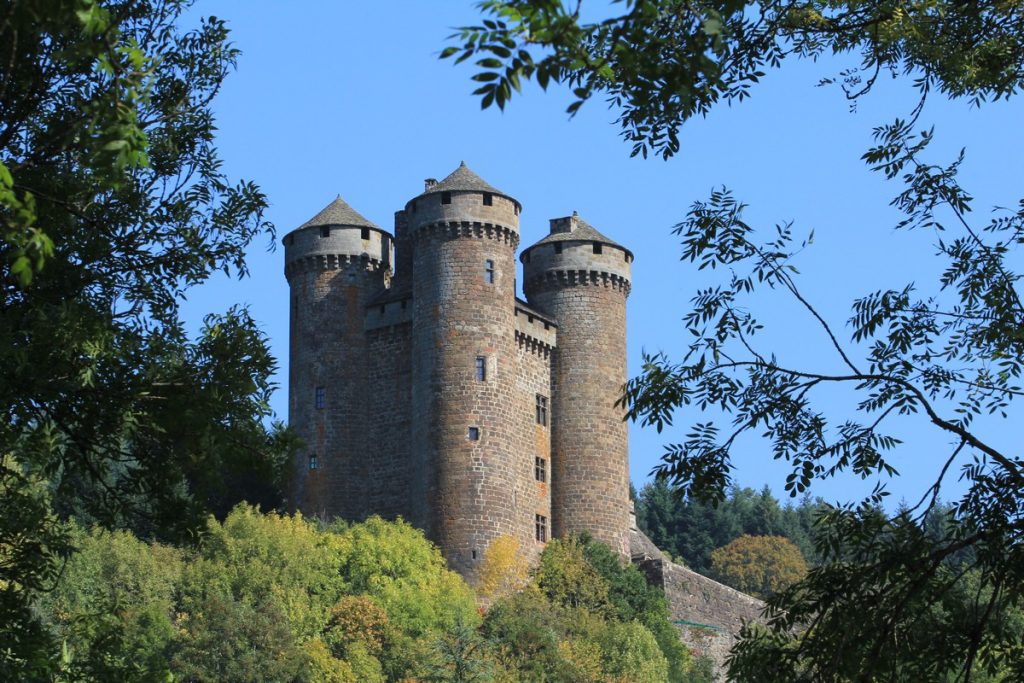
[Chateau Anjony Tournemire Cantal Auvergne]
We like to stroll through the alleys of Tournemire and discover the houses and their monumental stones, but there is no question of leaving the village without having visited the Château d'Anjony, which has survived time and turmoil while remaining intact. An impressive dungeon that houses rooms furnished and decorated with remarkable frescoes ...
For more information, visit: www.salers-tourisme.fr
The Lake of St Etienne Cantalès
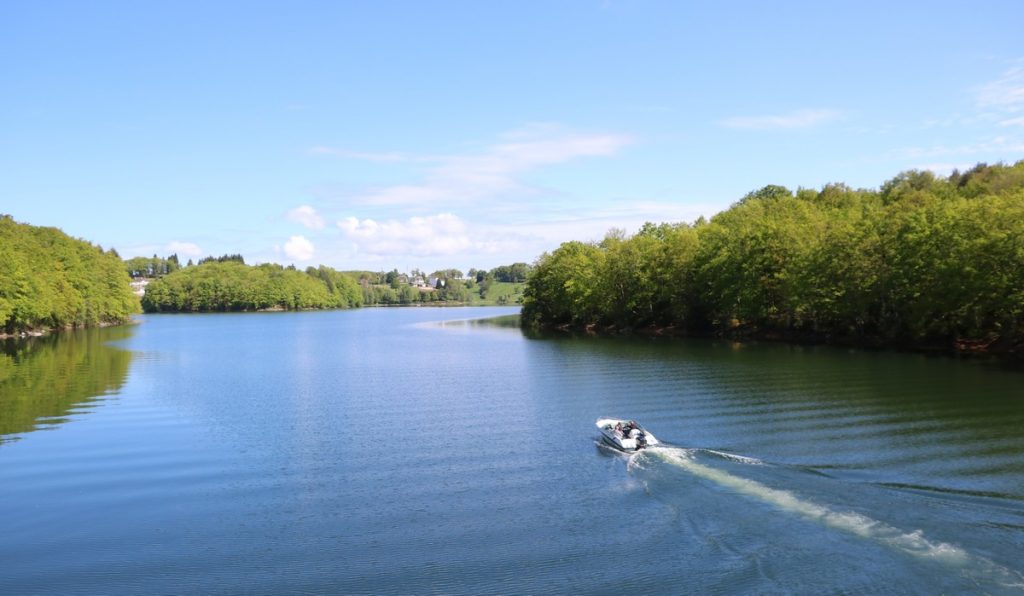
[Lac Saint Etienne Cantales in Cantal Auvergne]
For a break by the water or to indulge in water sports, head to the St Etienne Cantalès Dam! This 600 hectare water reservoir is a true vacation paradise. We recommend a walk on the trail at Puech des Ouilles, or the Rénac footbridge for thrill seekers. But if you prefer to swim or have fun in the water, rest assured, there are many activities waiting for you!
For more information, visit: www.chataigneraie-cantal.com
Saint Flour, city of art and history
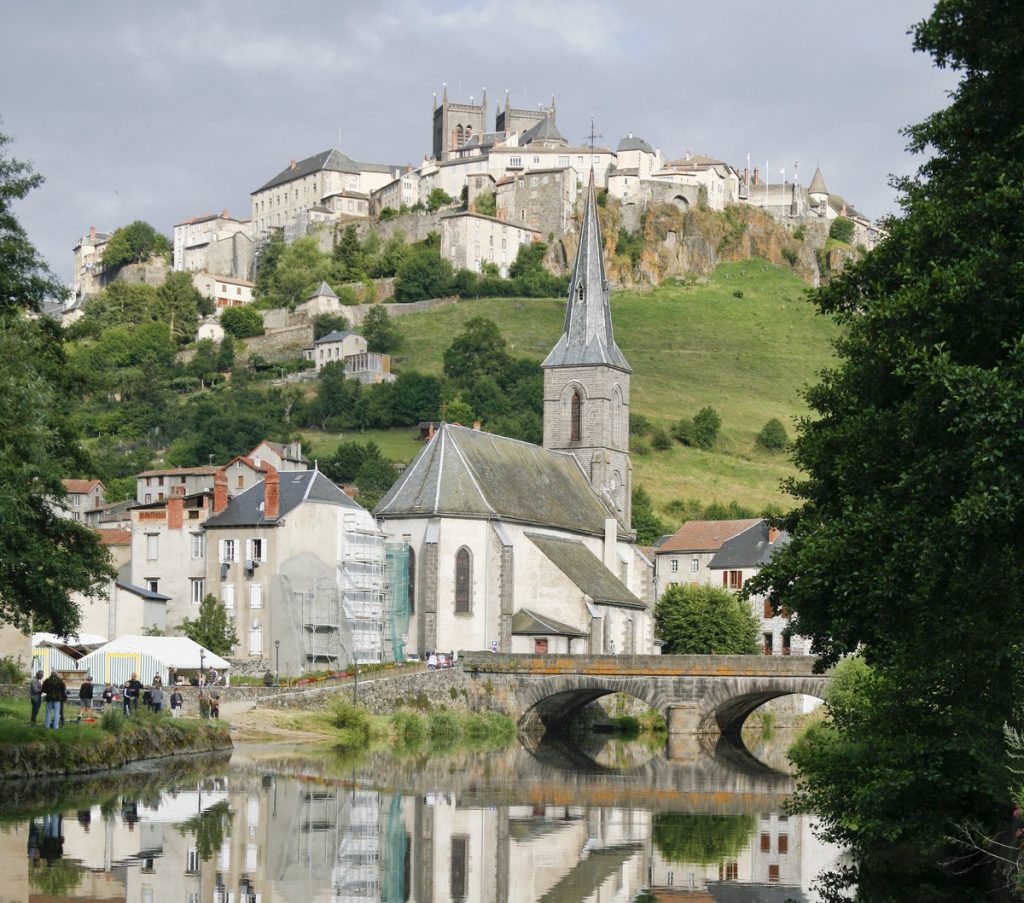
[Saint Flour and its cathedral]
From the top of its volcanic promontory, Saint Flour dominates the Cantal planèze. 15 centuries of history to discover, this is what this city has in store for you. Do not miss the natural ramparts of volcanic origin, which gives Saint Flour all its originality, nor the Saint Pierre cathedral with its original and surprising facade. The Tourist Office offers audio guides for a visit of the city at your own pace (three circuits are possible).
For more information, visit: www.pays-saint-flour.fr
Massif de la Pinatelle and the Lac du Pêcher: discovering the fauna of the Massif Cantalie
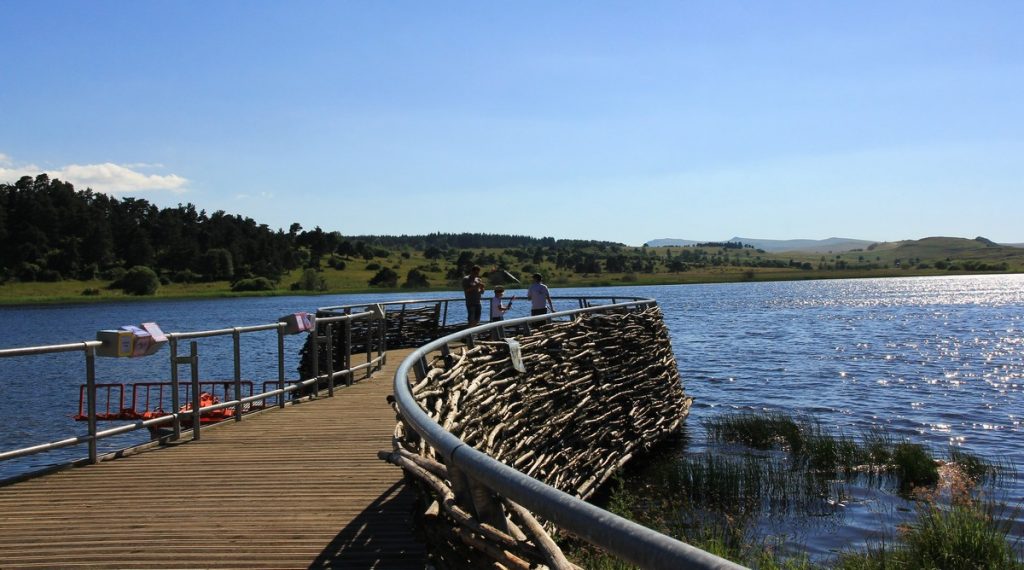
[Lac du Pêcher in Murat cantal auvergne]
On the Chalinargues plateau enter the Pinatelle forest, a veritable island of pines in the middle of the summer pastures. In particular, it is home to deer, which we love to go and listen to in the fall. Around the Lac du Pêcher, we invite you to set off on the discovery trail set up for a 100% nature walk, punctuated by the exploration of wildlife using panels and desks. Not to mention the bird observatory installed by the lake!
For more information, go to: www.hautesterrestourisme.fr
The Lioran resort and the Plomb du Cantal
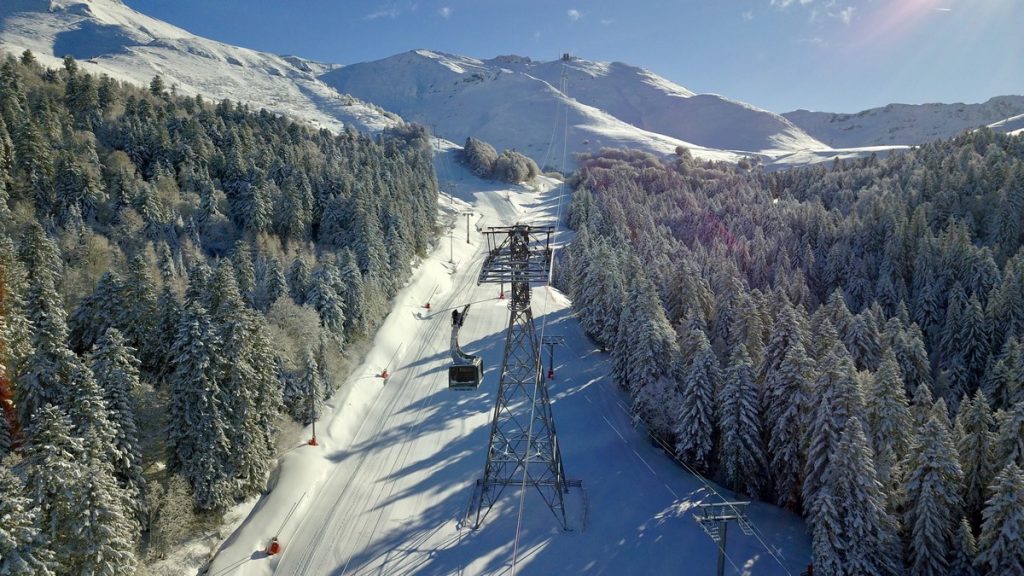
[Cable car from Lioran station to Plomb du Cantal]
Le Lioran is the Cantal resort! In winter we have a blast on the 60km of ski slopes, and in summer we have plenty of natural sensations. And for an unforgettable panorama whatever the season, board the cable car and get to the roof of Cantal! !
For more information, visit: www.lelioran.com
Chaudes Aigues: the warmest waters in Europe!

[Source from Par at Chaudes Aigues Auvergne]
We visit Chaudes Aigues along the water, from the Source du Par which exits at 82 °, to the Geothermal Museum, passing through the hot water wash house and the Caleden thermoludic center… A unique discovery in Cantal to be made in family!
For more information, visit: www.chaudesaigues.com
Auzers Castle
 The Château d'Auzers built in 1364, in the middle of the Hundred Years War. And this, like many strongholds that can still be discovered in this region. It was then the fortified castle as the children imagine it. This monument undergoes Jacqueries at the beginning of the 15th century, however, by marrying Alix de Bompar in 1470 who brought him the lands of Auzers as a dowry, Antoine de Douhet decided to settle forever in Auzers and restore this now family home. Their name will then become Douhet d'Auzers. Name that continues to bear the current owners, direct descendants of this union and makes it one of the oldest families in France. Thus the vision that we can have of the Château d'Auzers is more or less the one that existed at the beginning of the XVIth Century. On entering, one might have feared dark places and a resolutely rustic style, on the contrary, in the many rooms open to the public (some of which still benefit the family) a deep and unusual human warmth ... The Château d'Auzers built in 1364, in the middle of the Hundred Years War. And this, like many strongholds that can still be discovered in this region. It was then the fortified castle as the children imagine it. This monument undergoes Jacqueries at the beginning of the 15th century, however, by marrying Alix de Bompar in 1470 who brought him the lands of Auzers as a dowry, Antoine de Douhet decided to settle forever in Auzers and restore this now family home. Their name will then become Douhet d'Auzers. Name that continues to bear the current owners, direct descendants of this union and makes it one of the oldest families in France. Thus the vision that we can have of the Château d'Auzers is more or less the one that existed at the beginning of the XVIth Century. On entering, one might have feared dark places and a resolutely rustic style, on the contrary, in the many rooms open to the public (some of which still benefit the family) a deep and unusual human warmth ...
Val Castle
 The Château de Val, built in the 15th century by the Estaing family, was transfigured by the impoundment of the Bort dam which isolated it, with its chapel, on a peninsula connected to the land by a jetty . It has since occupied one of the most picturesque sites in Haute Auvergne. This imposing fortress is flanked by six towers crowned with machicolations and topped with pepper-pot roofs, the different covers of which give the roof of Val an original shimmer of color. In the main courtyard, a Gothic chapel (historic monument), also from the 15th century, is dedicated to Saint-Blaise. You enter the castle through an iron-clad door, the tympanum of which is adorned with a bas-relief with the fleur-de-lis coat of arms of the d'Estaing. A spiral staircase leads to the various floors through a vestibule, which originally was an interior courtyard without a roof. The first floor has three large rooms whose decoration (ceilings and fireplaces) dates from the mid-19th century. The second floor is reserved, each year, for exhibitions of works by the greatest contemporary painters. On the top floor, from the rampart walk, we discover a splendid panorama of the lake. The frame of the towers is interesting for the importance and the work of its elements. Once the capital of a barony, belonging to the Thynières family, Val was sold by Guillaume de Thynières to Guillot d´Estaing, who undertook the construction of the current castle in 1440, on the foundations of the old fortress. At the foot of the castle a beach has been set up (supervised swimming) as well as a nautical base with departures for boat rides. After several abandonments and successive restorations, the castle of Val has been the property of the city of Bort-les-Orgues since 1953. It is located in the town of Lanobre, in Cantal. The Château de Val, built in the 15th century by the Estaing family, was transfigured by the impoundment of the Bort dam which isolated it, with its chapel, on a peninsula connected to the land by a jetty . It has since occupied one of the most picturesque sites in Haute Auvergne. This imposing fortress is flanked by six towers crowned with machicolations and topped with pepper-pot roofs, the different covers of which give the roof of Val an original shimmer of color. In the main courtyard, a Gothic chapel (historic monument), also from the 15th century, is dedicated to Saint-Blaise. You enter the castle through an iron-clad door, the tympanum of which is adorned with a bas-relief with the fleur-de-lis coat of arms of the d'Estaing. A spiral staircase leads to the various floors through a vestibule, which originally was an interior courtyard without a roof. The first floor has three large rooms whose decoration (ceilings and fireplaces) dates from the mid-19th century. The second floor is reserved, each year, for exhibitions of works by the greatest contemporary painters. On the top floor, from the rampart walk, we discover a splendid panorama of the lake. The frame of the towers is interesting for the importance and the work of its elements. Once the capital of a barony, belonging to the Thynières family, Val was sold by Guillaume de Thynières to Guillot d´Estaing, who undertook the construction of the current castle in 1440, on the foundations of the old fortress. At the foot of the castle a beach has been set up (supervised swimming) as well as a nautical base with departures for boat rides. After several abandonments and successive restorations, the castle of Val has been the property of the city of Bort-les-Orgues since 1953. It is located in the town of Lanobre, in Cantal.
Anjony Castle
 Built by Louis d'Anjony, companion of Joan of Arc who received from King Charles VII the mission to protect the surroundings, the keep of Anjony is still there, intact and proud, a very characteristic example of small 15th century mountain fortresses. Its history was tumultuous in the XVth and XVIth centuries, because a real "vendetta" opposed the family of Anjony to that of Tournemire, too close neighbors and rivals. In the 18th century, a more welcoming main building was added to the austere medieval construction, more in keeping with the tastes of the time. Rich interiors decorated with remarkable frescoes from the 16th century and furniture from various periods in the life of the castle. The house has always been inhabited by the same family since the beginning. Typical specimen of medieval military architecture, although built around 1430. Quadrangular keep flanked by 4 round towers, one of which contains a helical staircase serving the whole building. It is crowned by a walkway on all 4 sides and each tower has its own. Built by Louis d'Anjony, companion of Joan of Arc who received from King Charles VII the mission to protect the surroundings, the keep of Anjony is still there, intact and proud, a very characteristic example of small 15th century mountain fortresses. Its history was tumultuous in the XVth and XVIth centuries, because a real "vendetta" opposed the family of Anjony to that of Tournemire, too close neighbors and rivals. In the 18th century, a more welcoming main building was added to the austere medieval construction, more in keeping with the tastes of the time. Rich interiors decorated with remarkable frescoes from the 16th century and furniture from various periods in the life of the castle. The house has always been inhabited by the same family since the beginning. Typical specimen of medieval military architecture, although built around 1430. Quadrangular keep flanked by 4 round towers, one of which contains a helical staircase serving the whole building. It is crowned by a walkway on all 4 sides and each tower has its own.
Sédaiges Castle
 15th century watchtower, nestled at an altitude of 700 m in an 8 ha park. with view on the Monts d'Auvergne. A military haunt from the 12th century, Sédaiges was a witness and actor in the Franco-English struggles in medieval Auvergne. Rebuilt as a fortress in the 15th century, embellished in the 18th century, this impressive castle also offers a unique example of the Troubadour architecture of the 19th century. The same family has always occupied it, which has allowed it to retain a spectacular interior decoration. In these private rooms, scenes from Sophie's Misfortunes come to life. Period characters and costumes, old games, ceremonial crockery, the facets of a vanished world shine in the setting of listed woodwork and tapestries. 15th century watchtower, nestled at an altitude of 700 m in an 8 ha park. with view on the Monts d'Auvergne. A military haunt from the 12th century, Sédaiges was a witness and actor in the Franco-English struggles in medieval Auvergne. Rebuilt as a fortress in the 15th century, embellished in the 18th century, this impressive castle also offers a unique example of the Troubadour architecture of the 19th century. The same family has always occupied it, which has allowed it to retain a spectacular interior decoration. In these private rooms, scenes from Sophie's Misfortunes come to life. Period characters and costumes, old games, ceremonial crockery, the facets of a vanished world shine in the setting of listed woodwork and tapestries.
Pesteils Castle
 Perched on its steep rock at an altitude of 750 meters, the ancient fortress of Polminhac proudly dominates the Cère Valley. Forty meters high, crowned with a floor of machicolation, the imposing keep symbolizes all the majesty of the castle of Pesteils and evokes the Middle Ages in its harshest expression (14th and 15th centuries). During the second half of the 17th century, the main building and the corner pavilion were redone, in the troubadour fashion, by the architect Émile Lemaigre at the start of the 19th century; all projects were kept. In the 19th century their interior decorations were reworked in neo-Gothic style and then refitted at the beginning of the 20th century. XVth century frescoes were restored in 2008 (Sotheby's prize), as well as painted ceilings, furniture, an old kitchen which received the La Cornue prize. Murals from the first quarter of the 20th century by Félix Tourdes (1855-1920) have been classified as a historical monument as an object since 19803. The park of the Château de Pesteils was redesigned at the beginning of the 20th century, it has an earthen terrace -full, a vegetable garden and an orchard. It was registered in the pre-inventory of remarkable gardens ... The 17th century enriches the main body with remarkable painted ceilings. The whole presents a very beautiful furniture. Expanded and restored in the 19th century, the castle has been owned since 1608 by the Cassagne family. Perched on its steep rock at an altitude of 750 meters, the ancient fortress of Polminhac proudly dominates the Cère Valley. Forty meters high, crowned with a floor of machicolation, the imposing keep symbolizes all the majesty of the castle of Pesteils and evokes the Middle Ages in its harshest expression (14th and 15th centuries). During the second half of the 17th century, the main building and the corner pavilion were redone, in the troubadour fashion, by the architect Émile Lemaigre at the start of the 19th century; all projects were kept. In the 19th century their interior decorations were reworked in neo-Gothic style and then refitted at the beginning of the 20th century. XVth century frescoes were restored in 2008 (Sotheby's prize), as well as painted ceilings, furniture, an old kitchen which received the La Cornue prize. Murals from the first quarter of the 20th century by Félix Tourdes (1855-1920) have been classified as a historical monument as an object since 19803. The park of the Château de Pesteils was redesigned at the beginning of the 20th century, it has an earthen terrace -full, a vegetable garden and an orchard. It was registered in the pre-inventory of remarkable gardens ... The 17th century enriches the main body with remarkable painted ceilings. The whole presents a very beautiful furniture. Expanded and restored in the 19th century, the castle has been owned since 1608 by the Cassagne family.
Saint-Pierre Cathedral of Saint-Flour (15100 Saint-Flour)
 Saint-Pierre de Saint-Flour Cathedral is one of the four cathedrals in Auvergne. It is located in the heart of the city of Saint-Flour (Cantal), on the Place d'Armes lined with arcades and towards which many old streets converge. Gothic in style, it was completed at the end of the 15th century, on the site of a Romanesque basilica, but was severely damaged during the Revolution. As with other religious buildings in the region, the material used is volcanic stone - black lava from Liozargues - which gives it a characteristic dark color. A first sanctuary was built to house the remains of Florus, the first apostle of Haute-Auvergne. In the 11th century, Odilon de Mercœur, abbot of Cluny founded the priory of Saint-Flour and built a Romanesque basilica that Pope Urbain II consecrated in 1095. In 1317 the basilica was erected into a cathedral. After the partial collapse of the north side of the building in 1398, Bishop Hugues de Manhac entrusted its reconstruction to Hugues Joly. A new cathedral, in flamboyant Gothic style, with three naves and four towers, was consecrated by Bishop Antoine de Montgon in 1466. During the Revolution, the building was ransacked and transformed into a temple of the Supreme Being. The cathedral was not returned to worship until 1802. Between 1846 and 1856 major restoration work was undertaken and the two side towers were demolished. The cathedral was classified as a historical monument on October 30, 1906. In 1966, the ceremonies of the fifth centenary of the cathedral brought together Mgr. Pourchet, the apostolic nuncio in France, Georges Pompidou, then Prime Minister, and Mgr. Maziers, bishop of Bordeaux. The altitude at the square (892 m) makes it the highest cathedral in Europe. Saint-Pierre de Saint-Flour Cathedral is one of the four cathedrals in Auvergne. It is located in the heart of the city of Saint-Flour (Cantal), on the Place d'Armes lined with arcades and towards which many old streets converge. Gothic in style, it was completed at the end of the 15th century, on the site of a Romanesque basilica, but was severely damaged during the Revolution. As with other religious buildings in the region, the material used is volcanic stone - black lava from Liozargues - which gives it a characteristic dark color. A first sanctuary was built to house the remains of Florus, the first apostle of Haute-Auvergne. In the 11th century, Odilon de Mercœur, abbot of Cluny founded the priory of Saint-Flour and built a Romanesque basilica that Pope Urbain II consecrated in 1095. In 1317 the basilica was erected into a cathedral. After the partial collapse of the north side of the building in 1398, Bishop Hugues de Manhac entrusted its reconstruction to Hugues Joly. A new cathedral, in flamboyant Gothic style, with three naves and four towers, was consecrated by Bishop Antoine de Montgon in 1466. During the Revolution, the building was ransacked and transformed into a temple of the Supreme Being. The cathedral was not returned to worship until 1802. Between 1846 and 1856 major restoration work was undertaken and the two side towers were demolished. The cathedral was classified as a historical monument on October 30, 1906. In 1966, the ceremonies of the fifth centenary of the cathedral brought together Mgr. Pourchet, the apostolic nuncio in France, Georges Pompidou, then Prime Minister, and Mgr. Maziers, bishop of Bordeaux. The altitude at the square (892 m) makes it the highest cathedral in Europe.
Saint-Leger Church (15400 Cheylade)
 The Saint-Léger church in Cheylade is a Roman Catholic church dedicated to Saint Léger, it was built in the 12th century, remodeled in the 15th century and 17th century. It is built in rhyolite (local volcanic stone) and covered with phonolite slate (volcanic lava that emits an almost crystalline sound when struck). The apse and the apse are the oldest parts, the apse opens with a triumphal arch which rests on columns surmounted by capitals with acanthus leaves. The statue of Saint Léger dates from the 5th century. You can also admire in front of the altar a granite cross dating from the Middle Ages and in the background a font and baptismal font from the 15th century. With a solid and massive appearance, due to the heavy pillars which separate the nave from the aisles, the Saint-Léger church dates from the 12th century, for its oldest part. Finished around 1743, it uses elements of the medieval Bestiary, so let the flowers, the real or fantastic animals, the angels painted on these vaults astonish you. It contains an astonishing vault of 1428 polychrome griffins; chimeras, symbols, colored flowers, familiar animals, cherubs, coats of arms of the families of Dienne or Rochemonteix, enigmatic designs, are painted in bright colors on the oak caissons of the three vaults of the church. All the patterns are different, this inspired polychromy makes the small church, after the Wars of Religion, a unique place in the region and undoubtedly in France. This decoration would have been carried out between 1610 and 1614 by Italian artists. The church also contains a 14th century wooden Christ, baptismal font and a 15th century holy water font, as well as a statue of Saint Léger, the patron saint of the parish. This was a starving man, if his legend is to be believed. For his feast, the pious souls of the parish used to deposit food in the church. One day, the victuals were not deposited, immediately the Saint disappeared. We trembled, we hastened to repair the fault and we found Saint Léger in a nearby wood, his mouth stuffed with lingonberries ... The Saint-Léger church in Cheylade is a Roman Catholic church dedicated to Saint Léger, it was built in the 12th century, remodeled in the 15th century and 17th century. It is built in rhyolite (local volcanic stone) and covered with phonolite slate (volcanic lava that emits an almost crystalline sound when struck). The apse and the apse are the oldest parts, the apse opens with a triumphal arch which rests on columns surmounted by capitals with acanthus leaves. The statue of Saint Léger dates from the 5th century. You can also admire in front of the altar a granite cross dating from the Middle Ages and in the background a font and baptismal font from the 15th century. With a solid and massive appearance, due to the heavy pillars which separate the nave from the aisles, the Saint-Léger church dates from the 12th century, for its oldest part. Finished around 1743, it uses elements of the medieval Bestiary, so let the flowers, the real or fantastic animals, the angels painted on these vaults astonish you. It contains an astonishing vault of 1428 polychrome griffins; chimeras, symbols, colored flowers, familiar animals, cherubs, coats of arms of the families of Dienne or Rochemonteix, enigmatic designs, are painted in bright colors on the oak caissons of the three vaults of the church. All the patterns are different, this inspired polychromy makes the small church, after the Wars of Religion, a unique place in the region and undoubtedly in France. This decoration would have been carried out between 1610 and 1614 by Italian artists. The church also contains a 14th century wooden Christ, baptismal font and a 15th century holy water font, as well as a statue of Saint Léger, the patron saint of the parish. This was a starving man, if his legend is to be believed. For his feast, the pious souls of the parish used to deposit food in the church. One day, the victuals were not deposited, immediately the Saint disappeared. We trembled, we hastened to repair the fault and we found Saint Léger in a nearby wood, his mouth stuffed with lingonberries ...
All these sites are a selection of the surprising discoveries that await you in Cantal! Come and meet us, we can advise you and offer you many other ideas for visits to do during your vacation! |
|
Leisures :
Loisirs
Tennis :500 m
Piscine :6 km
Pêche :500 m
Equitation :6 km
Ski de fond :3 km
Ski de piste :12 km
Randonnée : sur place
Gare :6 km
Commerces :1 km
Sites et itinéraires touristiques
Chapelle N-D de Consolation
Eglise gothique, rétable (XVIIe s.), chaire de bois (XVIIe s.), Christ assis, dans une vitrine (dentelle, cadeau d'Anne d'Autriche)
Nombreuses randonnées et promenades (GR 400).
Chaumière de Granière (Niervèze : Maison du Parc des Volcans)
La Perle de la Vallée de la Cère :
Au creux de la haute vallée de la Cère, entre deux chaînes de montagnes qui dominent les sommets de l'Elancèze et du Puy Gros, le bassin de Thiézac, qui s'élargit entre les étranglements du Pas-de-Compaing et du Pas-de-Cère, offre aux touristes et aux artistes peintres ses sites, sa fraîcheur et la luminosité incomparable de son ciel. Thiezac est par excellence le lieu où il fait bon vivre et se reposer.
|
|
|
|
|
|
|

